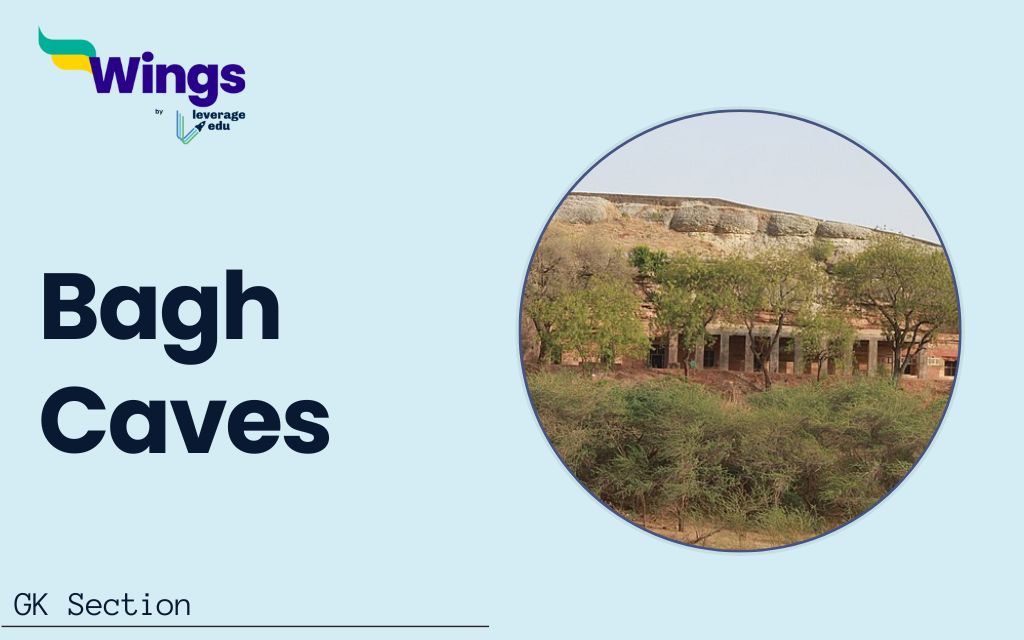The Bagh caves are a kind of cave architecture built during the late 4th and 6th centuries AD. These are nine rock-cut monuments located in Madhya Pradesh. These caves are excellent examples of rock-cut architecture and mural painting. These are monuments that represent the spiritual and artistic development of ancient India. In this section, we will go over the Bagh Caves in further detail. This is an important subject and may appear in various competitive examinations, including, UPSC, SSC, and EPFO. Continue reading to enhance your knowledge about such topics.
Contents
Historical Background of Bagh Caves
The Bagh Caves are located in the Dar district of Madhya Pradesh. These caves were carved into the southern slopes of the Vindhya Range during the 4th and 6th centuries AD. These caves are famous for their beautiful paintings, which are known as the best examples of Indian mural art.
- The Bagh Caves came into existence at a time when Buddhism was flourishing.
- The Buddhist monks used that peaceful and isolated location for meditation and prayer.
- The caves were primarily used as viharas (monastic residences) and chaityas (prayer halls).
- The architectural style of these caves is influenced by the Gupta period, which is also known as the golden age of Indian art and culture.
- These caves resemble the Ajanta Caves, which had rock-cut architecture and mural paintings.
Also Read: Gupta Sculpture: Characteristics and Influence
Architectural Layout
The Bagh Caves were built on the sandstone cliff and placed in a row. These caves face the Baghani River. There were nine caves in total, but only five were left over the years.
- Out of the five caves, the fourth one is the most important and well-preserved.
- Each cave has a unique layout; some are Viharas, others are Chaityas.
- Viharas are simple buildings with small rooms where monks lived and meditated.
- Chaityas are more complex with semicircular halls and stupas. This location was a focal point for worship.
- The interior of the caves is decorated with carved pillars and arches, showing the architectural skills of the time.
- The use of stones represented the high level of skill of craftspeople, who worked on the caves.
Art of Bagh Caves
The Bagh Caves was known for its beautiful mural paintings and earned the title of the “Ajanta of the Vindhyas.” These murals represent scenes from the Jataka Tales, as well as pictures of Bodhisattvas, gods, and heavenly beings.
- The paintings were made with the tempera technique. This technique involves mixing the colours and applying them to a dry surface.
- These murals are known for their fluid lines, natural figures and complex details. All of these features create a sense of movement and emotion.
- One of the most famous murals in the Bagh Caves portrays Bodhisattva Padmapani, a kind figure holding a lotus.
- The images of Cave 4 resemble the paintings of Ajanta Caves.
- The murals at Bagh Caves are famous for their beauty, elegance, and naturalistic expression of human figures.
Also Read: Elephanta Caves: Historical and Cultural Significance
Significance of Bagh Caves
The Bagh Caves have been important since ancient times. Some of its significance is discussed below.
- They offer valuable insights into the religious and cultural life of ancient India, especially during the Gupta period.
- The architecture of caves and murals offer evidence of the advanced artistic capabilities of the time.
- Murals are an important source of information from that time. They serve as a link between the murals of the Ajanta caves and those of the medieval period.
- The Bagh Caves also reflected the influence of Buddhist art and philosophy on Indian culture.
- The Bagh Caves were lost for years until they were discovered in the 19th century by a British archaeologist. Since then, attempts have been made to protect and restore the caves.
Modern-Day Relevance of Bagh Caves
The Bagh Caves were rediscovered in the 19th century and are now protected by the Archaeological Survey of India. These caves play an important role in Indian history.
- They attract thousands of tourists and historians to admire the architectural skills of these caves.
- Efforts to preserve these architectural masterpieces are ongoing, and researchers are still studying the advanced craftsmanship of ancient India.
- The Bagh Caves are an example of India’s rich cultural legacy.
The Bagh Caves are witnesses to the architectural legacy of the ancient period. The caves’ beauty and historical significance make them a key component of India’s heritage.
Related Posts
| Art and Architecture of Gupta Empire | UPSC Prelims Question Papers |
| Chaityas And Viharas | UPSC Prelims Eligibility Criteria 2024 |
| What is the Full Form of UPSC? | UNESCO World Heritage Site |
| UPSC Prelims Exam Pattern 2024 | Know All About The Indian History |
FAQs
The Bagh caves are a kind of cave architecture built during the late 4th and 6th centuries AD. These are nine rock-cut monuments located in Madhya Pradesh. These caves are excellent examples of rock-cut architecture and mural painting.
The Bagh Caves are related to the philosophy of Buddhism. The Bagh Caves came into existence at a time when Buddhism was flourishing.
The Bagh Caves are famous for their rock-cut architecture and mural paintings. These caves show an important part of the Gupta period, which is the golden age of Indian art and culture.
This was all about the “Bagh Caves”. For more such informative blogs, check out our UPSC Exams Section and Study Material Section, or you can learn more about us by visiting our Indian exams page.
 One app for all your study abroad needs
One app for all your study abroad needs














